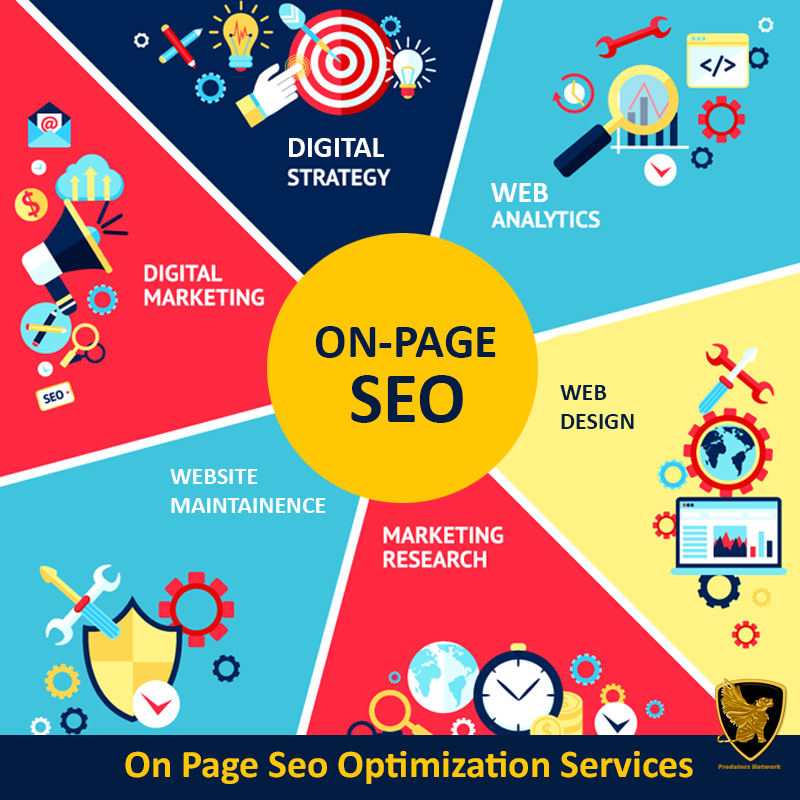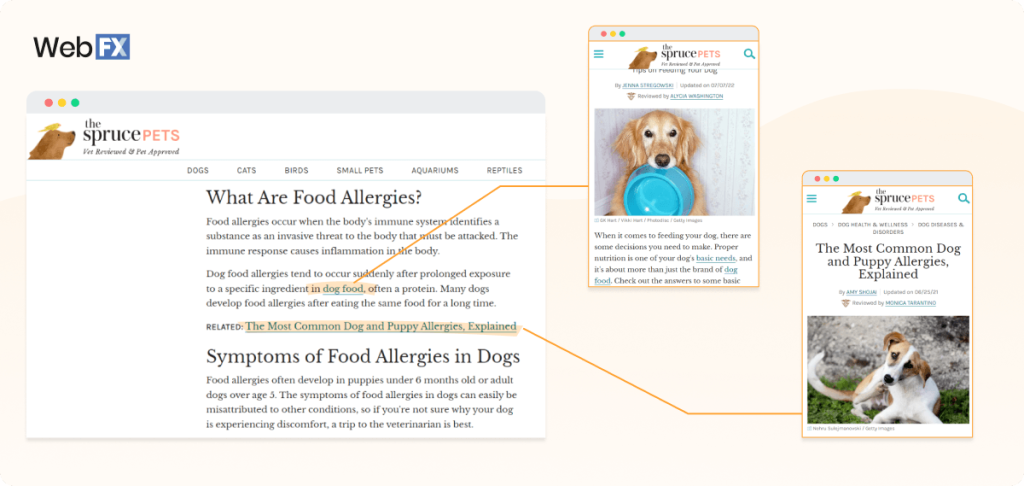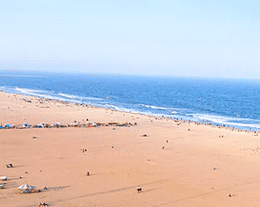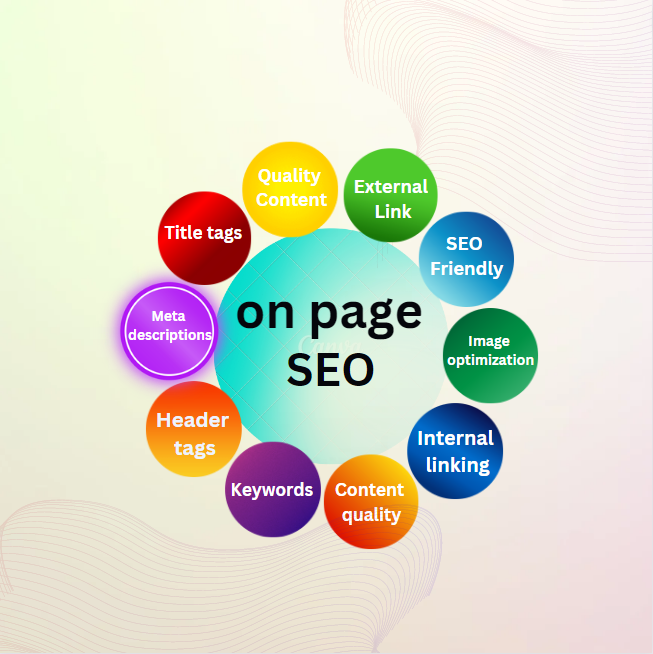
- On Page seo The method of improving elements on your website pages, like page speed and happiness, in order to improve your positioning and perceptibility in web search tool results pages (SERP), is known as on-page SEO.
- Your page’s URL, content, and flexibility are some of the on-page positioning factors.
- There’s a difference between off-page website design upgrades and on-page SEO. While off-page search engine optimization includes improvements outside of your website, on-page SEO focuses on improvements within the website itself.
If you own a website for your company, you are likely familiar with and understand the fundamentals of improving website design. Anyway, do you understand how to improve the design of your website on-page and how to include local innovations to improve your visibility in search engine results?
We’ll explain search engine optimization—specifically, on-page website design enhancement—on this page.
Here is a brief synopsis of everything we will discuss:
On-page SEO is the process of optimizing a web page to rank higher in search engines. It’s also known as on-site SEO or on-page optimization.
How it works: On Page seo
- on page SEO, Material: Make use of noteworthy catchphrases for your headers, subheadings, title labels, and body material.
- Page structure: Make use of inner links to help customers navigate your website and point web crawlers to new sites.
- Page speed: To improve page stacking speed, reduce picture sizes and pack picture documents.
- Meta-depictions: Use precise meta-portrayals and captivating language.
- Adaptability: Make sure your website is dynamic. Advantages attract more people to your website, increase organic traffic, improve the perception of your image, and help customers quickly locate relevant information.
- Enhancement of on-page versus off-page website design Optimization for search engines Off-page website design enhancement, which includes enhancing external indicators like backlinks, is not exactly the same as on-page SEO.Advice
What are the benefits of on-page SEO?
On-page SEO is important for your overall strategy and leads to :
- Higher search rankings
- Increased traffic to your website
- More conversions
Your ideal interest group will view your company and website as relevant assets for their needs since your content caters to their pursuing goals. Web indexes will also receive indications from the supporting content on your website that it is a valuable resource for those in the field.
On-page SEO takes time to show results, but once you start making progress with your on-page website design upgrade methods, your web-based rankings and sales can rocket.
12 On page SEO ranking factors to optimize
On-page web optimization positioning components come in various forms. A brief overview of factors that affect your on-page SEO is provided below.Be aware that doing local web optimization and seeing the results of your efforts will cost money. In any event, following the guidelines for these components will help you create a website that can withstand calculating refreshes.
12 on page SEO site ranking factors:
1.URL
2.Title tag
3.Meta description
4.Heading tags
5.Alt tags
6.Keywords
7.Content
8.Images
9.Page speed
10.Internal links
11.Schema markup
12.Mobile friendliness
Here’s how to optimize for these on-site SEO factors:
1. URL: Use a descriptive and optimized URL
Google advises using URLs that provide visitors with immediate information about a page. This is due to the possibility that fragments of the URL may appear in the SERPs, revealing to searchers which pages may be useful to them.
All things considered, remembering your objective catchphrase for your URLs is a fundamental practice of on-page web optimization.
A good URL for your website regarding dog daycares in Daytona Oceanside, for example, might be www.yoursite.com/canine-childcares-in-Daytona. Or, if you have different areas, you may use the following arrangement: www.yoursite.com/areas/daytona/canine childcare.

In addition to making your website easier to navigate, remembering your catchphrase for your URL instead of a lengthy string of jumbled digits gives visitors a better idea of the topics of your pages.
Which of the following URLs would you rather visit, for example?
- https://www.example.com/category/subcategory/keyword.html
- https://www.example.com/125typu4f5ww56fifl6639j875fe.html
Use clean, organized URLs—like the first example above—to improve your site’s architecture and help you rank higher in relevant search results.
2. Title tag: Include your target keyword in your title tag
Google needs to know what’s happening with your website before it will request to display your site in web crawler results pages (SERPs). Web search tool crawlers will find your site easier if you provide explicit watchwords in the title tag of each page.
If you’re concentrating on the keyword “canine childcare Daytona Oceanside,” for example, you may create the title tag that goes with it: “Head Honcho Childcare in Daytona Oceanside | Organization Name.”

For optimal results, use your chosen catchphrase toward the beginning of your title tag and keep it inside 50 to 60 characters to prevent Google from deleting it in list items.
Make sure you use a great title tag for every page to let clients and web search engines know what’s happening on each page.
Meta description: Use your meta description to encourage searchers to click your page
A meta representation doesn’t directly affect your on-page optimization. In any event, a component makes your page more recognizable to customers.The client search terms that appear in your meta representation will be prioritized by Google. Therefore, it makes sense to improve your meta representation for on-page SEO. Remember your center and related catchphrases for your meta portrayal for the best outcomes.
4. Heading tags: Improve your content’s with heading tags
Both web indexes and the two clients benefit from heading labels. To break up your content and make it easier for clients to read and scan, use heading labels throughout.
For example, the following headings could be used in a post regarding dog daycare:
- What does dog daycare include?
- How much does dog daycare cost?
- How to find the best dog daycare
When composing your heading labels, make sure to focus on your center catchphrase in your H1 tag. Need to really take a look at your page’s comprehensibility? Run your page through our free Lucidness Test.
5. On page SEO Alt tags: Use an alt tag for your multimedia content
Alt credits are used by web search engines to identify media because they are unable to see images.
If you have a picture of an apple, for example, your alt tag might read “red tasty apple.” Past that, you can add graphic names to the picture documents themselves so Google can find out about your media.
6. Keywords:On page SEO.
Every page on your website On Page seo should have text that discusses the topic of the page.
In fact, even sites that are typically left unimproved, like the “Get in Touch with Us” page, can help your company gain credibility online. Employing watchwords throughout your page’s body helps Google comprehend and appropriately rank it.
Look for catchphrases for each page of your website and use them. Tools for researching catchphrases, such as KeywordsFX and Keywordtool.io, can help you figure out what keywords people are using to find your products and services.
Investigate supportive metrics, such as monthly volume and competition, to determine which catchphrases are most valuable to you.
Generally speaking, smaller businesses will focus on catchphrases that are three to four words long or lengthy tail watchwords.
Although long-tail watchwords sometimes have lower monthly search numbers, they often face less competition. Because lengthy tail catchphrases are more explicit, it is typically easier to translate the inquiry plan behind them.
7. Content: Publish helpful On page SEO.
Basic content is available on-site. improvement of website design. You can persuade customers to visit your website by using content.
People browse your content, whether it’s to read a blog post or an item page. Increasing the quality of your content will help search engines understand and rank it, which can lead to people visiting your website.
Enhancements to on-page website design for content revolve around the following practices:
- Writing helpful content
- Using your keywords in headings and paragraphs
- Breaking your content into skimmable headings
- Complementing your content with helpful images
- Ensuring your content uses correct spelling and grammar
on page SEO. Duplicate content refers to blocks of similar content on multiple pages on your website—and it’s undesirable for two reasons:
Google doesn’t know which page to rank: When numerous site pages contain the exact same information, search engines won’t know which page to rank in search results.
Copy material confuses visitors: When visitors see copy content on your website, it might confuse them and make it difficult for them to know what to do next. Your substance channel is ruined by copy content, which also prevents your audience from acting.
8.Images:
High-quality images are essential for both website optimization and your clientele. They help visitors understand your stuff better.
You can distinguish your stuff with photos. They also provide context for unclear procedures or difficult-to-depict highlights.
Here are some examples of best practices for search engine optimization:
- Pack your images to avoid slowing down your page
- To make your photos open and improve your Google Pictures ranking, provide alt text.
- Include features that are convenient, such as records for recordings.
- Another exceptional place to include your goal catchphrases is in records and alt text, and combining them can help make your website ADA-compliant.
9. Page speed: Mind your site speed:
Do you have the patience to wait two minutes for a page on a website to load? The majority of web-based clients, like you, will ignore a page that doesn’t load quickly.
Improving your page speed is crucial to improving the client’s on-location experience because web indexes like Google also consider it as a positioning variable.
Are you tenacious enough to wait two minutes for a page to stack? The majority of web-based customers, like you, will quickly abandon a page that doesn’t stack.
Optimizing your page speed is essential to improving the client’s on-location experience because web search engines like Google also utilize it as a positioning factor.
To see how long it takes for a page to load, use PageSpeed Bits of Knowledge. PageSpeed Experiences will provide you with modified suggestions for speeding up your website. The possibilities are endless if you adhere to a few recommended practices for page speed, like compressing images and eliminating unnecessary site code.
10. Internal links:
In terms of on-page website SEO, inner connection is often overlooked. In any case, it’s essential to cultivate an internal linking mechanism as your website grows. This is because internal linking helps crawlers explore your website, discover fresh content, and determine how different pages are put up.
Having almost no internal linking on your pages negatively affects the client’s ability to access important content on your website. Additionally, if they are unable to access it, that directly affects your rate of change.

- Adding links to relevant, existing content in new posts
- Adding links from relevant, existing content to new pages
11. Structured data: Add schema markup
On page seo Use diagram markup if you think your page should be prominent in the SERPs. Code known as blueprint markup, or ordered information, aids web crawlers in understanding and categorizing websites.
Google uses it to display rich results, which are essentially indexed lists that provide various details about the page and are really engaging. These results can improve your SERP navigation rates and attract more snaps.
Other common types are:
- Recipes
- Local business
- Breadcrumb
- Carousel
12. Mobile friendliness: Make your website mobile friendly
Since mobile devices account for more than half of all web traffic, it is essential to streamline your website for versatility. Google even uses a flexible initial algorithm to rank websites.
The concept of portable resemblance has been abandoned. It’s essential, especially if you want your catchphrases to score well.
Developing a responsive website is often the main focus of on-page optimization for adaptability. You have a single website with a responsive design, which makes it easy to update and add new content.
Utilize tools such as Google Beacon to truly examine the adaptability of your website.
Get professional on page SEO help
On Page seo takes time and is an ongoing process. If you and your team need help to improve your on-page SEO, you can turn to WebFX.
We’re a full-service digital marketing agency with 5+ years of experience. Our award-winning team of SEO professionals is pumped to learn about your business, industry, and goals to deliver the results you need and grow your bottom line.
- Contact us today or mail iD: rebalguru99@gmail.comto learn more about our on-page SEO services or other professional SEO services we offer!
ALL THE BEST :👍




